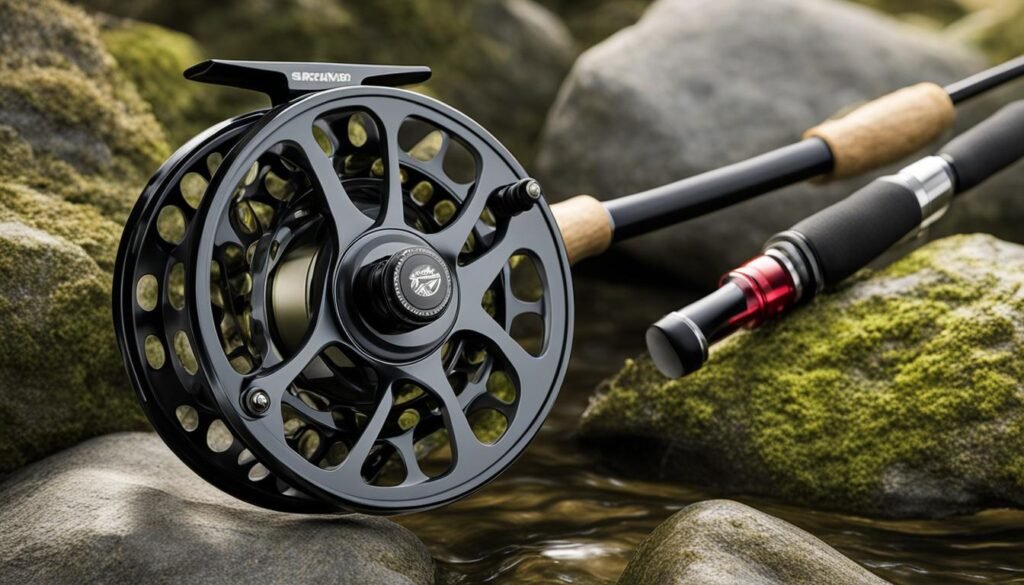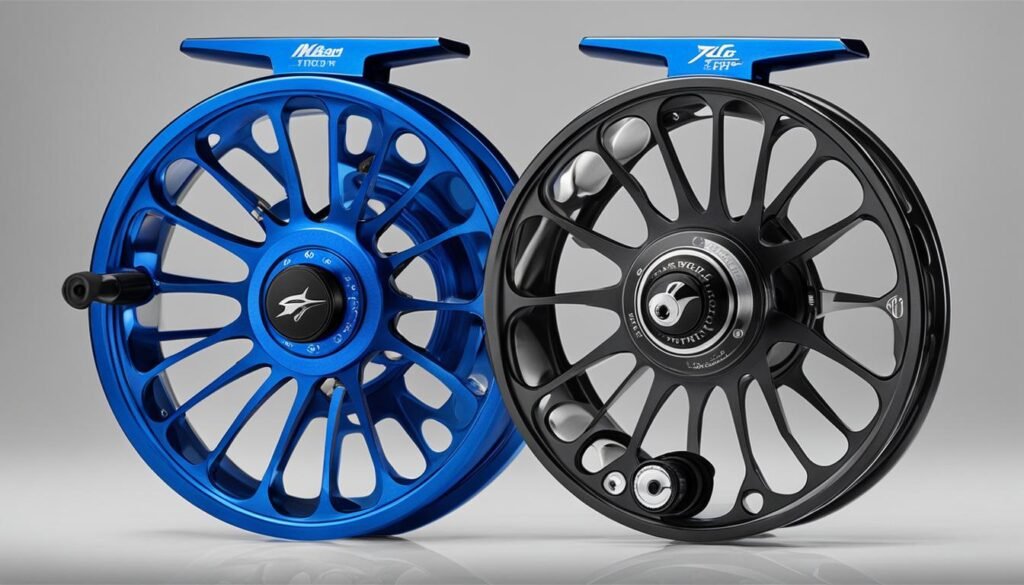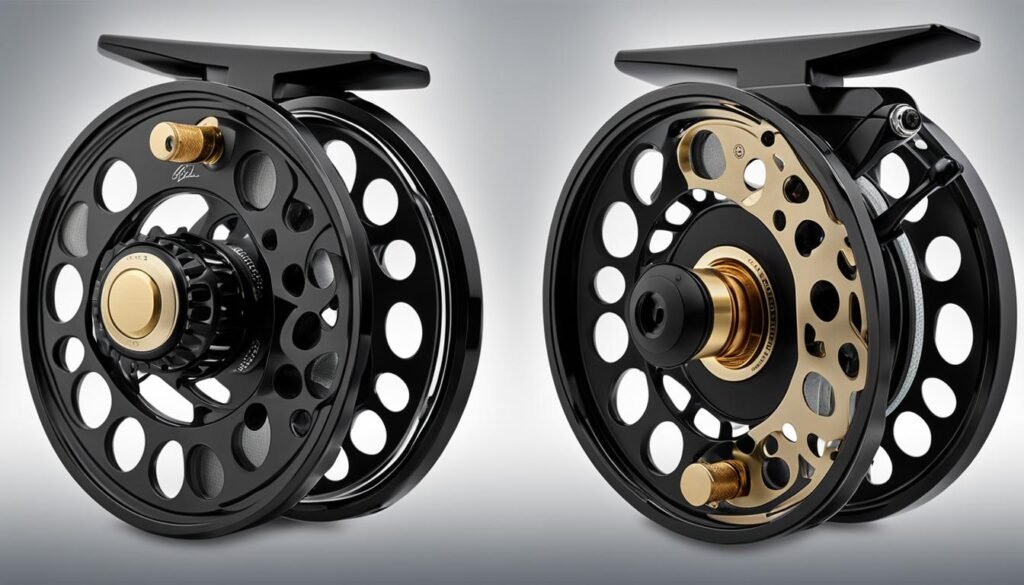Welcome to our ultimate guide on choosing the right fly fishing reel! Whether you’re a seasoned angler or just starting out, having the right reel is crucial for a successful fishing experience. In this guide, we’ll walk you through the key factors to consider when selecting a fly reel, from materials and design to drag systems and size.
When it comes to fly fishing gear, the fly reel plays a vital role. It not only houses your fly line but also ensures smooth line retrieval and control during fights with fish. So, let’s dive in and explore everything you need to know in order to make the best choice for your fly fishing adventures.
Materials for Fly Reels
When it comes to fly reels, the choice of materials plays a crucial role in their overall performance and durability. Most fly reels available on the market today are made from various grades of aluminum. Higher-end models are typically machined from aircraft-grade bar stock, while lower-end models are cast from molds. Anodized aluminum reels are especially important for saltwater fly fishing as they provide added protection against scratches and corrosion.
Beginner-level fly reels are often made from graphite or plastic materials, which can be more affordable but are less durable and may not perform well over time. These reels are better suited for freshwater fly fishing where the conditions are less harsh. However, for those who are serious about saltwater fly fishing or have plans to fish in challenging environments, investing in a higher-quality aluminum reel is highly recommended.
Overall, the choice of material for your fly reel should be based on your fishing needs and the type of fishing you plan to do. If you’re targeting freshwater species and are on a budget, a graphite or plastic reel may suffice. However, if you’re venturing into saltwater fly fishing or want a reel that will last for years to come, opting for an anodized aluminum reel would be a wise investment.
| Materials | Pros | Cons |
|---|---|---|
| Aluminum | Durable, corrosion-resistant | Higher cost |
| Graphite or Plastic | Lightweight, affordable | Less durable, may not perform well in saltwater |
Design of Fly Reels

When it comes to fly reels, the design plays a crucial role in determining your fishing experience. Two popular design options that you’ll come across are full-frame reels and contemporary reels. Each design offers its own set of advantages and considerations, catering to different fishing styles and preferences.
Full-Frame Reels
A full-frame reel is characterized by its solid construction, encasing the spool completely. This design is favored by anglers who engage in euro nymphing setups or pursue larger fish species. The robust construction provides added durability and stability, making it suitable for challenging fishing conditions.
One of the key benefits of full-frame reels is their ability to accommodate additional line capacity. This feature allows anglers to use thicker lines or carry spare lines, enabling them to adapt to different fishing situations. Moreover, the enclosed design of full-frame reels provides improved line protection, reducing the risk of tangles and snags.
Contemporary Reels
On the other hand, contemporary reels offer a modern and innovative approach to fly reel design. These reels feature a spool that takes the place of the traditional “cage,” resulting in a lightweight and compact design. Contemporary reels are favored by anglers who prioritize ease of use and portability.
Contemporary reels often incorporate advancements in drag systems, allowing for smoother and more precise drag adjustments. Additionally, these reels come in various bright colors, adding a touch of aesthetics to your fishing gear. Whether you’re a seasoned angler or a beginner, contemporary reels provide a practical and visually appealing option.
| Design | Advantages | Considerations |
|---|---|---|
| Full-Frame Reels |
|
|
| Contemporary Reels |
|
|
Drag Systems in Fly Reels
When it comes to fly fishing reels, one of the key components to consider is the drag system. The drag system determines the amount of resistance the reel provides when a fish pulls on the line, helping you control the fight and prevent the line from breaking.
There are two main types of drag systems used in fly reels: disc drag and click-and-pawl drag.
Disc Drag
The disc drag system uses a series of discs to provide the resistance needed when a fish is hooked. These discs can be made from materials such as carbon or Teflon, which offer smooth and consistent drag performance. The number of discs in the system can vary, with more discs generally providing stronger drag capabilities. Disc drag systems are known for their reliability and ability to handle larger fish species.
Click-and-Pawl Drag
The click-and-pawl drag system, also known as a traditional or “old-school” drag system, relies on a clicker mechanism to create resistance. As the fish pulls on the line, the pawl engages with a gear to produce a clicking sound. While click-and-pawl drags may not offer the same level of control as disc drags, they provide a unique and nostalgic feel to the fishing experience. They are also typically found on lighter weight and more traditional fly reels.
When choosing a fly reel, consider the type of fishing you’ll be doing and the species you’ll be targeting. Disc drags are generally recommended for larger fish and situations where a smooth and powerful drag is necessary. Click-and-pawl drags, on the other hand, are well-suited for lighter weight setups and anglers who enjoy a more traditional fishing experience.
| Drag System | Advantages | Disadvantages |
|---|---|---|
| Disc Drag | Smooth and consistent drag performance, suitable for larger fish | May be more expensive, additional maintenance may be required |
| Click-and-Pawl Drag | Nostalgic feel, lighter weight, and more traditional | Less control, not ideal for heavy fish or strong runs |
Size and Arbor of Fly Reels
When selecting a fly reel, determining the appropriate size and arbor is crucial for optimal performance. The size of the reel should be balanced with the weight of the rod to ensure smooth casting and efficient line retrieval. Different fishing situations may require varying reel sizes, so it’s essential to consider your target fish species and the type of water you’ll be fishing in.
For trout and bass fishing in freshwater, smaller-sized reels are commonly used. These reels are lightweight and compact, making them perfect for casting smaller flies and providing the necessary line capacity for these types of fish. On the other hand, saltwater fishing often calls for larger-sized reels to handle the heavier lines and longer runs of powerful saltwater species. These larger reels also provide faster line pickup, reducing the risk of line entanglement and memory.
In addition to size, the arbor of a fly reel is another critical factor to consider. The arbor refers to the diameter of the spool that holds the fly line. Fly reels can have three different types of arbors: small, mid, and large. Larger arbors offer several advantages, including faster line retrieval and less line memory. With a larger arbor, you’ll be able to retrieve line more quickly, which can be advantageous when battling fast-swimming fish or when you need to make long casts. Additionally, larger arbors reduce line memory, preventing tangling and ensuring smoother casting.
Recommended fly reel sizes based on target fish species:
| Target Fish Species | Recommended Reel Size |
|---|---|
| Trout and Bass | Small to Medium |
| Salmon and Steelhead | Medium to Large |
| Saltwater Species | Large to Extra Large |
Choosing a Fly Reel Based on Target Species

When it comes to selecting the right fly reel, your choice should be based on the target species you will be fishing for. Different fish species have varying characteristics and behaviors, which require specific reel specifications to ensure a successful and enjoyable fishing experience.
For freshwater species like trout and bass, a reel with a lighter drag setting is suitable. “Click and pawl” reels are commonly used in freshwater fishing as they provide a more delicate and subtle drag system, ensuring a smooth fight with the fish. These reels are lightweight and perfect for smaller-sized fish found in freshwater bodies.
On the other hand, if you’re planning to fish in saltwater environments, you’ll need a reel with stronger drag capabilities and a larger size. Saltwater fish are typically more powerful and can make long, fast runs, requiring a reel that can handle the pressure. Saltwater fly reels are designed to withstand the corrosive nature of saltwater and are equipped with sturdy drag systems to prevent fish from running freely.
| Freshwater Fly Reel | Saltwater Fly Reel |
|---|---|
| Lighter drag | Stronger drag |
| Smaller size | Larger size |
| Perfect for trout and bass | Ideal for saltwater species |
Considerations When Buying a Fly Reel
When it comes to selecting a fly reel, there are several important factors to consider. Whether you’re an experienced angler or just starting out, finding an affordable fly fishing reel that meets your needs is essential. Here are some key considerations to keep in mind when buying a fly reel:
Price
Price is a significant consideration for many anglers. If you’re a frequent angler and plan on using your reel often, it’s worth investing in a higher-end reel made from durable materials. These reels tend to offer better performance and longevity, making them a worthwhile investment in the long run. However, if you’re an occasional angler or on a tight budget, there are plenty of lower-priced reels available that can still get the job done.
Material
The material the reel is made from is another crucial factor to consider. While aluminum reels are the most common, higher-end models are machined from aircraft-grade bar stock, providing superior strength and durability. These reels are ideal for saltwater fishing, where corrosion resistance is essential. On the other hand, beginner reels made from graphite or plastic may be more affordable but may not hold up as well over time, especially in harsh conditions.
Saltwater vs. Freshwater
Another consideration is whether you’ll be fishing in saltwater or freshwater environments. If you plan on fishing in saltwater, it’s important to choose a reel with a sealed drag system to prevent corrosion from saltwater exposure. Freshwater reels, on the other hand, may not require this feature. Consider the type of fishing you’ll be doing and select a reel that’s designed to handle the specific conditions you’ll encounter.
| Consideration | Saltwater | Freshwater |
|---|---|---|
| Price | Higher price range | Lower price range |
| Material | Anodized aluminum | Aluminum, graphite, or plastic |
| Drag System | Sealed drag system | No specific requirements |
Tips for Choosing a Fly Reel
When it comes to choosing a fly reel, there are a few important factors to consider. First, think about your personal preferences and style. The look and feel of the reel can make a difference in your overall fishing experience. So, choose one that appeals to you and matches your aesthetic taste.
Next, it’s crucial to avoid going for cheap reels that may not last long or have faulty parts. Investing in a quality fly reel is worth it, as it will ensure durability and performance. Look for reputable brands that are known for their reliability and customer satisfaction.
If you’re planning to fish in saltwater, it’s essential to take extra care of your reel. After each use, make sure to wash it thoroughly to prevent corrosion. Saltwater can be harsh on fishing equipment, so proper maintenance is key to prolonging the life of your reel.
Lastly, consider the size of the fly reel in relation to your rod and the target fish species. It’s important to have a balanced outfit to achieve optimal performance. Take into account the weight and size of the rod, and choose a reel that complements it well. Additionally, different fish species may require specific reel sizes and drag systems, so do your research before making a purchase.
FAQ
What are the factors to consider when selecting a fly reel?
When selecting a fly reel, factors to consider include materials, design, drag, and size.
What materials are fly reels made from?
Most fly reels on the market today are made from varying qualities of aluminum. Higher-end models are machined from aircraft-grade bar stock, while lower-end models are cast from molds. Beginner reels made from graphite or plastic may be cheaper but are less durable and perform poorly.
What are the different designs of fly reels?
Fly reel designs vary, with full-frame reels encasing the spool completely and contemporary reels having the spool take the place of the traditional “cage.” Full-frame reels are preferred for euro nymphing setups, while contemporary reels are lighter, easier to use, and have innovations in drag systems. Modern reels also feature bright colors for added aesthetics.
What are the different types of drag systems in fly reels?
Drag systems in fly reels can be disc drags or click-and-pawl drags. Disc drags use a brake system to provide consistent pressure during fights with fish. Click-and-pawl drags use cogs and gears for resistance. Disc drags are smoother and provide better performance, while click-and-pawl drags are simpler and less expensive. The number of discs in a disc drag system affects drag performance.
How does the size and arbor of a fly reel affect its performance?
Fly reel sizing is important for balancing with the rod. Larger arbors allow for faster line pickup and help prevent entanglement and memory in the fly line. Trout and bass fishing may require smaller-sized reels, while saltwater fishing may require larger reels to handle heavier lines and longer runs.
What type of fly reel should I choose based on the target species?
The choice of fly reel depends on the target species. For trout and freshwater bass, reels with lighter drag settings, such as “click and pawl” reels, are suitable. Saltwater fishing requires reels with stronger drags and larger sizes to handle the power of the fish. Choosing a reel that matches the weight of the rod is crucial for optimal performance.
What considerations should I keep in mind when buying a fly reel?
When buying a fly reel, price, material, and saltwater vs. freshwater considerations are important. Investing in a higher-end reel is recommended for frequent anglers to ensure durability and performance. For occasional anglers, lower-priced reels may suffice. Saltwater reels should have a sealed drag system to prevent corrosion, while freshwater reels may not require this feature.
Any tips for choosing a fly reel?
When choosing a fly reel, it’s important to consider your personal preferences, such as the look and style of the reel. Avoid going for cheap reels that may not last long or have faulty parts. Wash your saltwater reel after each use to prevent corrosion. Fly reel sizes should match the rod size and target fish species. Consider the price, material, drag system, and arbor size when making your decision.

